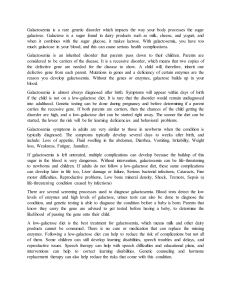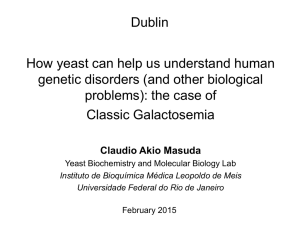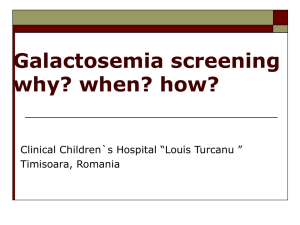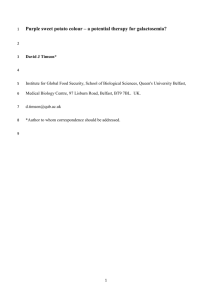Page 1 of 2 Medical Information Sheet GALACTOSEMIA What is
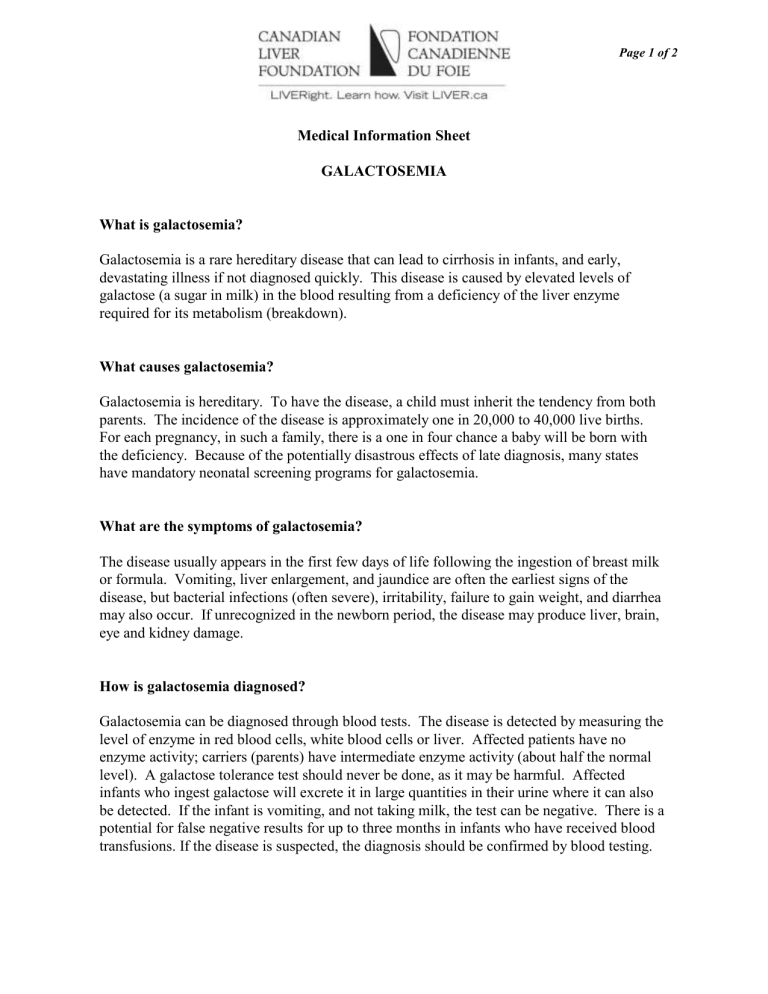
Page 1 of 2
Medical Information Sheet
GALACTOSEMIA
What is galactosemia?
Galactosemia is a rare hereditary disease that can lead to cirrhosis in infants, and early, devastating illness if not diagnosed quickly. This disease is caused by elevated levels of galactose (a sugar in milk) in the blood resulting from a deficiency of the liver enzyme required for its metabolism (breakdown).
What causes galactosemia?
Galactosemia is hereditary. To have the disease, a child must inherit the tendency from both parents. The incidence of the disease is approximately one in 20,000 to 40,000 live births.
For each pregnancy, in such a family, there is a one in four chance a baby will be born with the deficiency. Because of the potentially disastrous effects of late diagnosis, many states have mandatory neonatal screening programs for galactosemia.
What are the symptoms of galactosemia?
The disease usually appears in the first few days of life following the ingestion of breast milk or formula. Vomiting, liver enlargement, and jaundice are often the earliest signs of the disease, but bacterial infections (often severe), irritability, failure to gain weight, and diarrhea may also occur. If unrecognized in the newborn period, the disease may produce liver, brain, eye and kidney damage.
How is galactosemia diagnosed?
Galactosemia can be diagnosed through blood tests. The disease is detected by measuring the level of enzyme in red blood cells, white blood cells or liver. Affected patients have no enzyme activity; carriers (parents) have intermediate enzyme activity (about half the normal level). A galactose tolerance test should never be done, as it may be harmful. Affected infants who ingest galactose will excrete it in large quantities in their urine where it can also be detected. If the infant is vomiting, and not taking milk, the test can be negative. There is a potential for false negative results for up to three months in infants who have received blood transfusions. If the disease is suspected, the diagnosis should be confirmed by blood testing.
Page 2 of 2
How is galactosemia treated?
Treatment is based on the elimination of galactose from the diet. This may be done in the early neonatal period by stopping breast feeding and by the administration of diets which contain no lactose or galactose, (Nutramigen
®
, Pregestimil
®
). Soy-containing formulas can also be administered. This diet should be strictly followed, and continued for years, and possibly for life. The red blood cell levels of galactose or its metabolites (galactose-1phosphate) may be used as a monitor to gauge the adherence to the diet and restriction of galactose. It is also recommended that mothers of affected infants be placed on a galactosefree diet during subsequent pregnancies. This may somewhat modify symptoms present at birth. With early therapy, any liver damage which occurred in the first few days of life will nearly completely heal.
Galactosemia should be considered in any jaundiced infant because of beneficial effects of early dietary restriction.
This medical information sheet is current for June 2009.
For more information about liver health, galactosemia and other forms of liver disease, please contact:
Canadian Liver Foundation
National Office
2235 Sheppard Avenue East, Suite 1500
Toronto, Ontario
M2J 5B5
Tel: (416) 491-3353
Fax: (416) 491-4952
Toll-free line: 1-800-563-5483 http://www.liver.ca e-mail: clf@liver.ca
Canadian Charitable Registration Number: 10686 2949 RR0001


